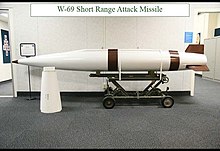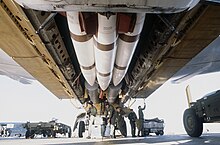
Back AGM-69 SRAM German AGM-69 SRAM Spanish AGM-69 SRAM Finnish AGM-69 SRAM French AGM-69 SRAM ID AGM-69 SRAM Italian SRAM (ミサイル) Japanese AGM-69 SRAM Korean Boeing AGM-69 SRAM Dutch AGM-69 SRAM Russian
This article includes a list of general references, but it lacks sufficient corresponding inline citations. (January 2009) |
| AGM-69 SRAM | |
|---|---|
 SRAM missile carrying a W69 warhead | |
| Type | Nuclear air-to-surface missile |
| Place of origin | United States |
| Service history | |
| In service | 1972–1993 |
| Used by | United States |
| Wars | Cold War |
| Production history | |
| Designer | Boeing |
| Designed | 1965 |
| Manufacturer | Boeing |
| Unit cost | $592,000 |
| Produced | 1971–1975 |
| No. built | 1,500 |
| Specifications | |
| Mass | 2,230 lb (1,010 kg) |
| Length | 15 ft 10 in (4.83 m) w/ tail fairing, 14 ft 0 in (4.27 m) without |
| Diameter | 17.5 in (0.44 m) |
| Warhead | W69 nuclear warhead |
| Blast yield | 170 to 200 kilotonnes of TNT (710 to 840 TJ) |
| Engine | Lockheed SR75-LP-1 two-pulse solid-fueled rocket |
Operational range | 110 nautical miles (200 km) |
| Maximum speed | Mach 3 |
Guidance system | General Precision/Kearfott KT-76 Inertial measurement unit |
| Accuracy | 1,400 ft (430 m) |
| Transport | Airplane |



The Boeing AGM-69 SRAM (Short-Range Attack Missile) was a nuclear air-to-surface missile. It had a range of up to 110 nautical miles (200 km; 130 mi), and was intended to allow US Air Force strategic bombers to penetrate Soviet airspace by neutralizing surface-to-air missile defenses.
The SRAM was designed to replace the older AGM-28 Hound Dog standoff missile which was tasked with the same basic role. The Hound Dog was a very large missile that could only be carried in pairs by the B-52, so some aircraft were tasked with suppressing Soviet missile and radar sites while others would carry on to strike their strategic targets. The SRAM was so much smaller that a number could be carried along with other weapons, allowing a single aircraft to blast a nuclear path through to its targets.
The SRAM entered service in 1972 and was carried by a number of aircraft, including the B-52, FB-111A, and the B-1B. In September 1980 a ground fire raised concerns about the safety of the warhead, and in 1990 they were temporarily removed from service while safety checks were carried out. These revealed a number of the missiles' rocket motors had developed cracks that could have resulted in them exploding when launched.
The SRAM was removed from service in 1993. The weapon was to be replaced by the AGM-131 SRAM II and the new W89 warhead, but the program was terminated at the end of the Cold War.